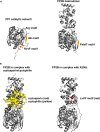Therapeutic strategies for anchored kinases and phosphatases: exploiting short linear motifs and intrinsic disorder
- PMID: 26283967
- PMCID: PMC4516873
- DOI: 10.3389/fphar.2015.00158
Therapeutic strategies for anchored kinases and phosphatases: exploiting short linear motifs and intrinsic disorder
Abstract
Phosphorylation events that occur in response to the second messenger cAMP are controlled spatially and temporally by protein kinase A (PKA) interacting with A-kinase anchoring proteins (AKAPs). Recent advances in understanding the structural basis for this interaction have reinforced the hypothesis that AKAPs create spatially constrained signaling microdomains. This has led to the realization that the PKA/AKAP interface is a potential drug target for modulating a plethora of cell-signaling events. Pharmacological disruption of kinase-AKAP interactions has previously been explored for disease treatment and remains an interesting area of research. However, disrupting or enhancing the association of phosphatases with AKAPs is a therapeutic concept of equal promise, particularly since they oppose the actions of many anchored kinases. Accordingly, numerous AKAPs bind phosphatases such as protein phosphatase 1 (PP1), calcineurin (PP2B), and PP2A. These multimodal signaling hubs are equally able to control the addition of phosphate groups onto target substrates, as well as the removal of these phosphate groups. In this review, we describe recent advances in structural analysis of kinase and phosphatase interactions with AKAPs, and suggest future possibilities for targeting these interactions for therapeutic benefit.
Keywords: A-kinase anchoring protein (AKAP); cAMP signaling; calcineurin; intrinsic disorder; protein kinase A (PKA); protein phosphatase 2B (PP2B); short linear interaction motifs (SLiMs).
Figures


References
-
- Alto N. M., Soderling S. H., Hoshi N., Langeberg L. K., Fayos R., Jennings P. A., et al. (2003). Bioinformatic design of A-kinase anchoring protein-in silico: a potent and selective peptide antagonist of type II protein kinase A anchoring. Proc. Natl. Acad. Sci. U.S.A. 100 4445–4450. 10.1073/pnas.0330734100 - DOI - PMC - PubMed
-
- Blumenthal D. K., Takio K., Hansen R. S., Krebs E. G. (1986). Dephosphorylation of cAMP-dependent protein kinase regulatory subunit (type II) by calmodulin-dependent protein phosphatase. J. Biol. Chem. 261 8140–8145. - PubMed
Publication types
Grants and funding
LinkOut - more resources
Full Text Sources
Other Literature Sources

